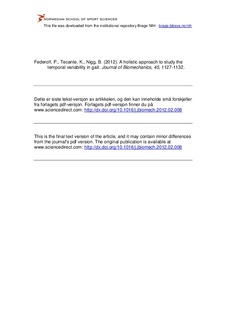A holistic approach to study the temporal variability in gait
Journal article, Peer reviewed
Permanent lenke
http://hdl.handle.net/11250/171006Utgivelsesdato
2012-04Metadata
Vis full innførselSamlinger
- Artikler / Articles [2119]
Originalversjon
Journal of Biomechanics. 2012, 45(7), 1127-1132Sammendrag
Movement variability has become an important field of research and has been studied to gain a better understanding of the neuro-muscular control of human movements. In addition to studies investigating “amplitude variability” there are a growing number of studies assessing the “temporal variability” in movements by applying non-linear analysis techniques. One limitation of the studies available to date is that they quantify variability features in specific, pre-selected biomechanical or physiological variables. In many cases it remains unclear if and to what degree these pre-selected variables quantify characteristics of the whole body movement. This technical note proposes to combine two analysis techniques that have already been applied for gait analysis in order to quantify variability features in walking with variables whose significance for the whole movements are known. Gait patterns were recorded using a full-body marker set on the subjects whose movements were captured with a standard motion tracing system. For each time frame the coordinates of all markers were interpreted as a high-dimensional “posture vector”. A principal component analysis (PCA) conducted on these posture vectors identified the main one-dimensional movement components of walking. Temporal variability of gait was then quantified by calculating the maximum Lyapunov Exponent (LyE) of these main movement components. The effectiveness of this approach was demonstrated by determining differences in temporal variability between walking in unstable shoes and walking in a normal athletic-type control shoe. Several additional conceptual and practical advantages of this combination of analysis methods were discussed.
Beskrivelse
I Brage finner du siste tekst-versjon av artikkelen, og den kan inneholde ubetydelige forskjeller fra forlagets pdf-versjon. Forlagets pdf-versjon finner du på www.sciencedirect.com: http://dx.doi.org/10.1016/j.jbiomech.2012.02.008 / In Brage you'll find the final text version of the article, and it may contain insignificant differences from the journal's pdf version. The definitive version is available at www.sciencedirect.com: http://dx.doi.org/10.1016/j.jbiomech.2012.02.008
